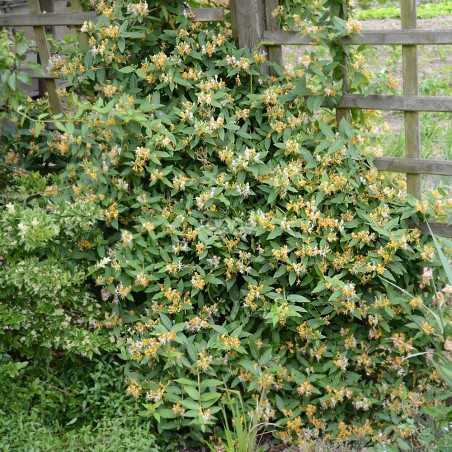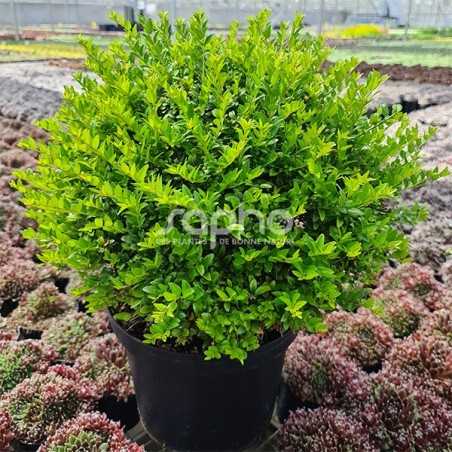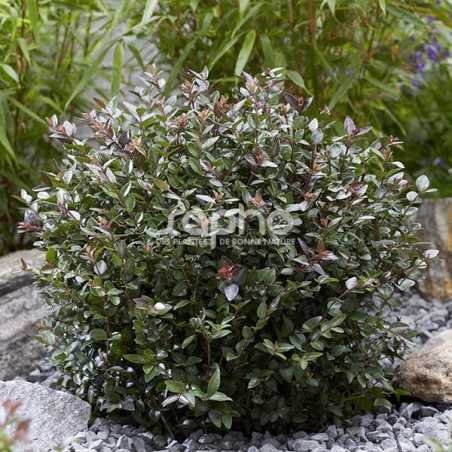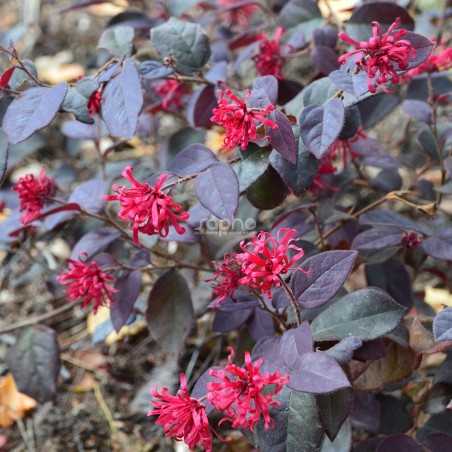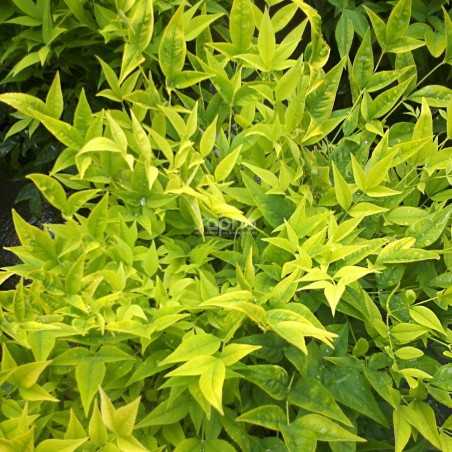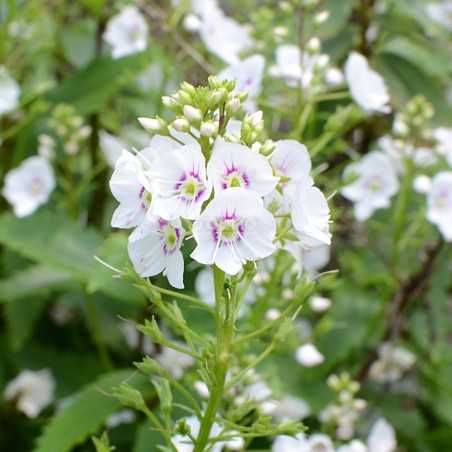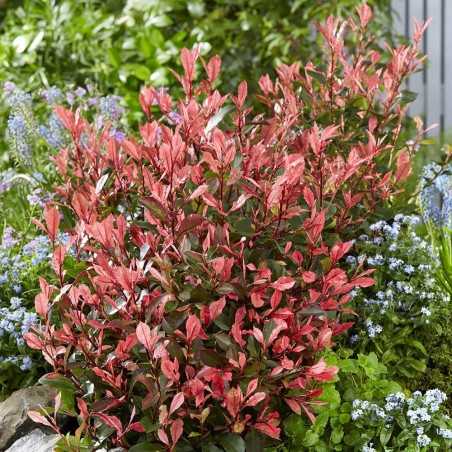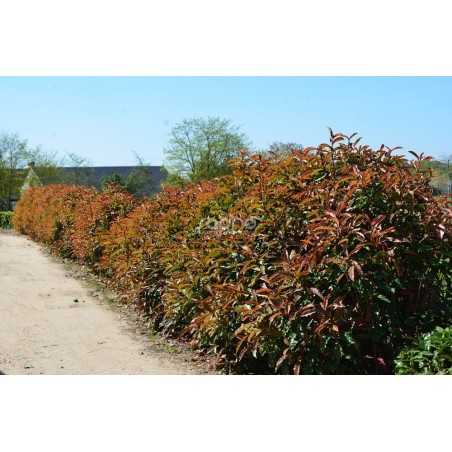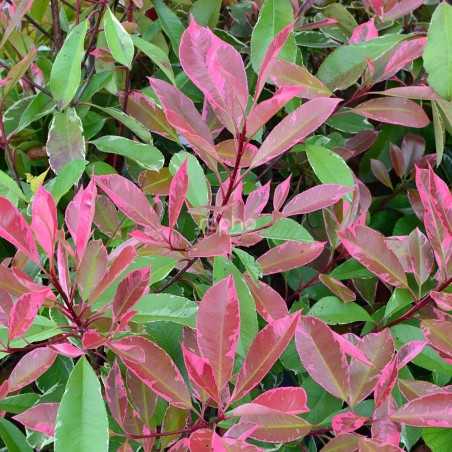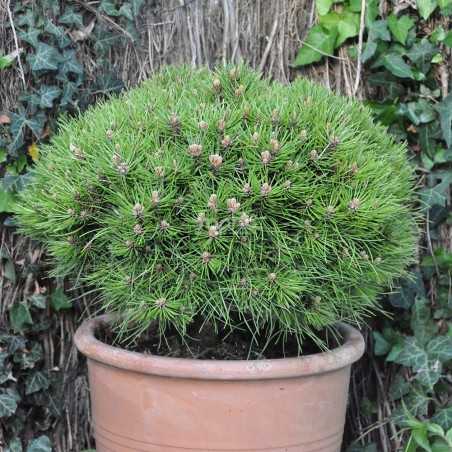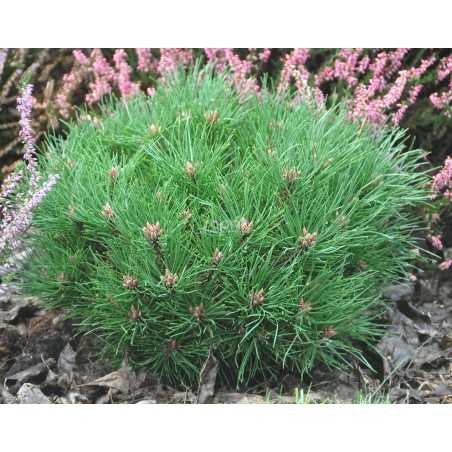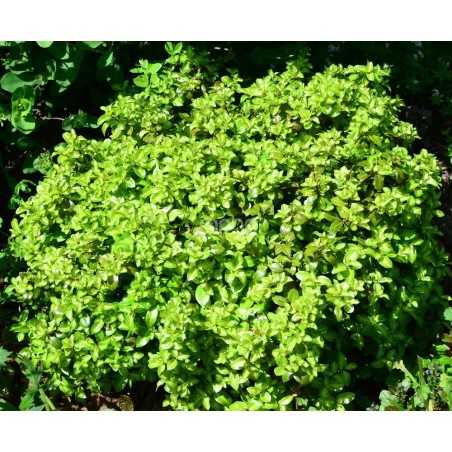Ever, always: dense foliage even in winter, fragrant flowers in summer, bluish fuits in autumn.This variety of climbing honeysuckle of our CAPRILIA ® range is a hybrid between Lonicera henryi and Lonicera japonica 'Aureoreticulata'.CAPRILIA ® Ever is hardy and shows good persistence in winter.This selection shows a lesser development than its parent plant Lonicera henryi.The plant flowers well in May - June, presents clusters of small flowers which stand out well against the foliage. Light violet to pink as buds and in bloom, the flowers then turn yellow orange before wilting. They are fragrant, unkike Lonicera henryi. Some second flowering is noticeable in September.Dark blue fruits appear at the end of summer and persist for a long time.The narrow, mid-green foliage resists well to blackspot, mildew and aphids.To be trained.
Filter By
Foliage
Position
Categories
Menu
All our varieties
A shrubby honeysuckle with evergreen foliage
GARDEN CLOUDS® Green Breeze is a variety of shrubby honeysuckle more resistant to cold than the typical species (-18° C).
Its dense habit, fine, glossy, light-green leaves and ease of cultivation make it easy to prune and use in topiary.
It adapts to all soils (unlike Ilex crenata) and is faster-growing than boxwood, with no health problems.
Use in the ground, borders, low hedges or pots.
A shrubby evergreen honeysuckle with magnificent purple shoots
GARDEN CLOUDS® Purple Storm is a variety of shrubby honeysuckle more resistant to cold than the typical species (-18° C).
Its dense habit, fine, glossy, light-green leaves with dark purple shoots and ease of cultivation make it easy to prune and use in topiary.
It adapts to all soils (unlike Ilex crenata) and is faster-growing than boxwood, with no health problems.
Use in the ground, borders, low hedges or pots.
Remarkable bright red flowers and beautiful purple foliage all year longThis evergreen Loropetalum is noticeable for its foliage, which stays very deep purple all year long.Its habit is compact, upright and spread, the dimensions are moderate.EVER RED® is particularly spectacular during its flowering period, from the end of February to May, depending on the climate. The beautifully sized flowers are shaped as pompoms of fine straps, caracteristic for the Hamamelidaceae family Their full red colour is highlighted by the dark foliage.Loropetalum like half shade, they tolerate light sun. Once established they suffer draughts.EVER RED® can be planted alone or in numbers, in a distance of 1.00 - 1.20 m, and also in pots on a terrace or a balcony when regularly watered.
In springtime its chartreuse coloured leaves are very attractiveA Nandina with a brand-new colour! The new shoots are yellow-green, chartreuse or also lime green and very bright. In full sun the outer leaves keep their chartreuse colour, whereas the inner leaves turn light green.Its shape is very interesting, forming a bushy and branched little shrub of under 1 m, like a ball.It never flowers, or very seldom.Recommended to illuminate the darker parts of the garden in the spring, it also accepts to be grown in pots.Trophies: Gold medal at PLANTARIUM 2014 (Boskoop - NETHERLANDS)Honored with a Retailer's Choice Award™ at SNA 2014
A deep foliage, abundant and delicate white flowers all summer longOriginating in New Zealand, this evergreen selection is hardy down to -12° C.It's leathery, regularly toothed leaves are first tender green, changing afterwards to a pretty dark green. The young stems are purple-brown.'Avalanche' is very floriferous from June to September. It covers itself in a cloud of simple, small white flowers with a purple center, standing out well on the foliage.Its long summer flowering, a quick growth and bushy shape make this variety an ideal plant for small spaces and pots.
A tiny Photinia full of energy! Made for balconies or low hedges
This variety of photinia is particularly compact and dense-growing, with sturdy stems.
Its dark green foliage contrasts with the bright pink young shoots.
An easy-care plant, it bears pruning well and branches well.
Perfect for pots, balconies or low hedges.
Chocolate coloured and toothed leaves : an original foliage with this new Photinia.The originality of the foliage brings a revival to the Photinia. The leaf blade is ondulated and finely toothed. The young shoots, copper at first, take on the unusual chocolate shade, and then turn dark green.This cultivation, tested in nurseries for several years, performs well: it branches and develops well in containers, its growth is good. Hardy, CRUNCHY® keeps its leaves in winter and has a good resistance to powdery mildew. It is therefore recommended for hedges, with or without clipping.Trophies: FIRST PRICE at FLORMAT - MIFLOR 2014 (Padova - ITALY)
Beautifully mixed colours and an upright and regular formIts variegated foliage brings colour throughout the year. Photinia Louise has also been selected for its vigorous, erect growth and its ample vegetation that's regular, compact and dense. Photinia Louise is a shrub with persistent leaves and changing colours. In spring and autumn the young shoots are bright red spotted with pink.The developing leaves become thick and green, spotted wih creamy white. Its flowers, in May, are quite discreet, forming creamy white umbels. Upkeep is easy as it needs little pruning other than that required by the garden. In a hedge, a mixed bed or as a solitary shrub, 2 to 3 m high, Photinia Louise will enliven a garden throughout the year.
A beautiful regular ball of 0,80 m high (fully grown).
Growth rate is 5 - 9 cm per year, slower than 'Pierrick Bregeon'.
Forms a compact dense mound.
Light green needles of up to 10 cm, can naturally and slightly turn yellow in winter. Spiraling needles at maturity. Viability of the needles: 3 to 4 years.
Small grey buds with a pointy tip
No resin production.
Like all the other varieties of the pine range, registered by H. BREGEON, its reduced growth allows this pine to be grown in pots, on terraces and on balconies, as well as in small modern gardens.
Bambino®, the smallest of the range.
The smallest variety (0.50 m fully grown) and of slowest growth rate.
The dark green needles stay on for 2 to 3 years.
Pointed buds.
Very slight resin production.
Like all the other varieties of the pine range, registered by H. BREGEON, its reduced growth allows this pine to be grown in pots, on terraces and on balconies, as well as in small modern gardens.
A golden ball for low hedges or in isolationThe variety 'Golden Ball' has very brilliant golden foliage. In its period of growth, its young golden-yellow leaves contrast with the older yellow-green leaves edged with a stronger green.Coming from the same breeding than Pittosporum tenuifolium 'Golf Ball', 'Golden Ball' has the same qualities: very dense, it naturally forms a ball of less than one meter. Fast-growing and branching from the base, it can be pruned. 'Golden Ball' is ideal for small spaces and low hedges as well as in pots and for topiary.As it is resistant to drought, wind and seaspray, it provides an alternative to box in temperate and Mediterranean areas. In May and June its small discreet violet-coloured flowers smell of honey.

